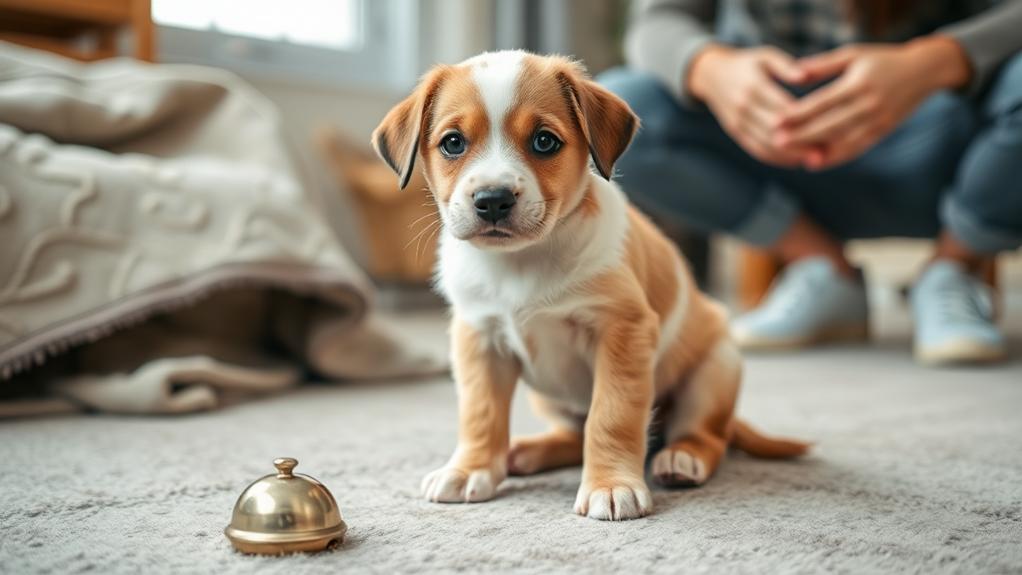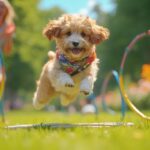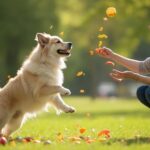Potty training your puppy starts by understanding their needs and setting up a consistent schedule. Take your puppy out every 2-3 hours, especially after meals or playtime. Choose a quiet, accessible spot for potty breaks and always take them there. Help your puppy learn by recognizing their signals like sniffing or whining. Use positive reinforcement—reward them right after they go outside. Be patient; accidents will happen, but they're part of the learning process. Stick with it, and soon you'll see progress. Keep going, and you'll discover more tips to make this journey easier for you and your puppy.
Understanding Your Puppy's Needs
Understanding your puppy's needs is essential for successful potty training. Puppies aren't just little bundles of joy; they have specific requirements that you need to recognize. First, consider their age. Younger puppies have smaller bladders and need to relieve themselves more frequently. Pay attention to their signals, like sniffing, whining, or circling, as these are signs they need to go out.
Moreover, your puppy's energy levels and routine play a pivotal role in understanding their needs. High-energy puppies might need more outdoor breaks to burn off steam, while calmer puppies may require less frequent potty breaks but still need a consistent schedule.
Nutrition also impacts their potty habits. A balanced diet can lead to more regular bowel movements, so make certain you're feeding them appropriate food. Lastly, remember that each puppy is unique; what works for one may not work for another. Observing your puppy's behavior and adjusting accordingly will make a significant difference in the training process. By being attentive and responsive to these various needs, you'll create a positive environment that fosters successful potty training and strengthens your bond with your puppy.
Setting Up a Potty Schedule

Creating a potty schedule is an essential step in training your puppy effectively. By establishing a routine, you'll help your puppy learn when it's time to go outside. Puppies generally need to relieve themselves after eating, drinking, playing, or waking up.
To set up your schedule, start by taking your puppy out first thing in the morning, then every 2-3 hours throughout the day. Also, make sure to take them out after meals and playtime. Consistency is key, so try to stick to the same times each day.
Here's a simple example of a potty schedule to get you started:
| Time | Activity |
|---|---|
| 7:00 AM | Take puppy outside after waking |
| 9:00 AM | Potty break after breakfast |
| 12:00 PM | Midday potty break |
Adjust the times based on your daily routine and your puppy's needs. Be patient and attentive; accidents may happen, but with a solid schedule, you'll soon see improvements. Celebrate successes to motivate your puppy and reinforce positive behavior!
Choosing the Right Potty Spot
When selecting the right potty spot for your puppy, consider a few key factors to make the process smoother. First, choose a location that's easily accessible for both you and your puppy. Think about areas close to your home, as this will make it convenient for frequent trips, especially during those early training days.
Next, look for a spot that's quiet and free from distractions. Puppies can get sidetracked easily, so a calm environment will help them focus on doing their business. Avoid busy areas with loud noises or other pets nearby.
Also, consider the surface of the potty spot. Grass is often ideal, as it's a natural texture that most dogs prefer. However, if you live in an apartment or a place without easy access to grass, you can train your puppy to use pee pads or artificial turf.
Lastly, guarantee the spot is consistent. Taking your puppy to the same place every time helps them associate that area with potty time, speeding up the training process. By choosing wisely, you set the stage for successful potty training.
Using Positive Reinforcement

Positive reinforcement is one of the most effective methods to encourage good potty habits in your puppy. By rewarding your furry friend for doing their business in the right spot, you create a positive association with the behavior. Start by keeping treats handy whenever you take your puppy outside. As soon as they finish pottying in the designated area, praise them enthusiastically and offer a treat. This immediate reward reinforces the action and helps your puppy understand what you expect.
Consistency is key. Always reward your puppy right after they potty, so they connect the dots between the behavior and the reward. Try using verbal praises like "good boy" or "good girl" along with treats. Over time, you can gradually reduce the number of treats but continue showering your pup with praise.
Be patient and understanding. If your puppy has an accident indoors, don't scold them; this can create fear and anxiety. Instead, focus on reinforcing the positive behaviors. With time, practice, and plenty of love, your puppy will learn to associate pottying outside with positive experiences, making the training process smoother for both of you.
Recognizing Potty Signals

To help your puppy develop good potty habits, it's important to recognize their potty signals. These signals indicate when your puppy needs to go outside. By paying attention, you'll be able to anticipate their needs and avoid accidents.
Here are some common potty signals you might notice:
| Signal | Description | Action to Take |
|---|---|---|
| Sniffing | Your puppy may sniff around areas of the house. | Take them outside immediately. |
| Circling | They might walk in circles or pace back and forth. | Bring them to their potty spot. |
| Whining or Barking | Vocalization can indicate urgency. | Respond quickly and go outside. |
| Squatting | You may see them lower their body. | Interrupt and take them out. |
| Scratching at the door | They might scratch or paw at the door. | Open the door and let them out. |
Dealing With Accidents

Accidents are bound to happen during the potty training process, especially in the early stages. When your puppy has an accident indoors, it's important to stay calm and avoid scolding them. Puppies don't understand that they've done something wrong, and punishment can create fear or anxiety around potty time. Instead, focus on cleaning the mess properly and preventing it from happening again.
First, use an enzymatic cleaner to eliminate odors that might encourage your puppy to return to the same spot. Make sure you thoroughly clean the area, as lingering smells can confuse your puppy about where it's acceptable to go.
Next, assess the situation. Were you giving your puppy enough opportunities to go outside? Did you miss their potty signals? Adjust your schedule accordingly. Increase the frequency of bathroom breaks, especially after meals, playtime, or waking up.
Transitioning to Outdoor Pottying

As your puppy gets the hang of potty training, it's time to move from indoor pottying to outdoor relief. Begin this shift by taking your puppy outside regularly, especially after meals, playtime, or naps. Establish a designated potty spot in your yard, so your puppy starts associating that area with bathroom time.
When you take your puppy outside, use a consistent command like "go potty" to encourage them. This helps them understand what you expect. Stay patient and give your puppy a few minutes to sniff around and do their business. If they go, make sure to praise them enthusiastically and offer a small treat as a reward.
If your puppy doesn't go right away, bring them back inside after a short while and try again later. It's crucial to maintain a routine, so consider taking them out at the same times each day. This consistency helps strengthen their understanding of outdoor pottying.
Maintaining Consistency and Patience

Consistency and patience are pivotal elements in successful potty training for your puppy. You've established a routine, and adhering to it is essential. Take your puppy out at the same times every day—after meals, playtime, and naps. This predictability helps your puppy learn when it's time to go outside.
While you're training, accidents will happen. Instead of getting frustrated, remind yourself that patience is key. Each mistake is a learning opportunity for both you and your puppy. When accidents occur, clean the area thoroughly to eliminate lingering odors that might tempt your pup to return to the same spot.
Positive reinforcement is another indispensable part of maintaining consistency. Whenever your puppy goes potty outside, shower them with praise or a treat. This reinforces the behavior you want to see and motivates them to repeat it.
Lastly, remember that every puppy learns at their own pace. Some may catch on quickly, while others might take a little longer. Embrace the journey, and don't rush the process. With your unwavering consistency and patience, you'll help your puppy become a potty-trained companion.
Conclusion
Potty training your puppy takes time and patience, but you've got this! By understanding your pup's needs, setting a consistent schedule, and using positive reinforcement, you'll foster good habits. Remember to recognize their signals and handle accidents calmly. As you move to outdoor pottying, stay consistent and patient—your hard work will pay off. Soon enough, your puppy will be well-trained and ready to enjoy their time with you, both indoors and out!



